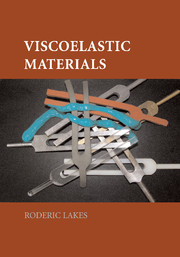Book contents
- Frontmatter
- Contents
- Preface
- 1 Introduction: Phenomena
- 2 Constitutive Relations
- 3 Dynamic Behavior
- 4 Conceptual Structure of Linear Viscoelasticity
- 5 Viscoelastic Stress and Deformation Analysis
- 6 Experimental Methods
- 7 Viscoelastic Properties of Materials
- 8 Causal Mechanisms
- 9 Viscoelastic Composite Materials
- 10 Applications and Case Studies
- A Appendix
- B Symbols
- Index
9 - Viscoelastic Composite Materials
Published online by Cambridge University Press: 21 January 2010
- Frontmatter
- Contents
- Preface
- 1 Introduction: Phenomena
- 2 Constitutive Relations
- 3 Dynamic Behavior
- 4 Conceptual Structure of Linear Viscoelasticity
- 5 Viscoelastic Stress and Deformation Analysis
- 6 Experimental Methods
- 7 Viscoelastic Properties of Materials
- 8 Causal Mechanisms
- 9 Viscoelastic Composite Materials
- 10 Applications and Case Studies
- A Appendix
- B Symbols
- Index
Summary
Introduction
Composite materials are those that contain two or more distinct constituent materials or phases, on a microscopic or macroscopic size scale larger than the atomic scale, and in which physical properties are significantly altered in comparison with those of a homogeneous material. In this vein, fiberglass and other fibrous materials are viewed as composites, but alloys, such as brass, are not. Semicrystalline polymers, such as polyethylene, have a heterogeneous structure, which can be treated via composite theory. Biological materials also have a heterogeneous structure and are known as natural composites. Composites may contain solid, liquid, and gas phases. For example, composites of gas and liquid include mist and foam; composites of solid and gas include foam and smoke. Composites with a structural role have several solid phases or a connected solid phase with gas or liquid in the interstices (structural foam and honeycomb).
Composite Structures and Properties
Ideal Structures
The properties of composites are greatly dependent upon microstructure. Composites differ from homogeneous materials in that considerable control can be exerted over the larger scale structure; and hence over the desired properties. In particular, the properties of a composite depend upon the shape of the heterogeneities, upon the volume fraction occupied by them, and upon the interface between the constituents. Volume fraction refers to the ratio of the volume of a constituent to the total volume of a composite specimen. The shape of the heterogeneities in a composite is classified as follows. The principal inclusion shape categories (Figure 9.1) are the particle, with no long dimension; the fiber, with one long dimension; and the platelet (flake, lamina), with two long dimensions.
- Type
- Chapter
- Information
- Viscoelastic Materials , pp. 341 - 376Publisher: Cambridge University PressPrint publication year: 2009
- 1
- Cited by



